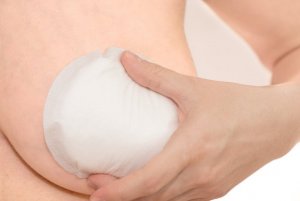What Are Protective Nursing Pads?

When women nurse, some drops of milk leak out of the breasts at any time of the day. To avoid stains on clothing, many women use protective nursing pads. Find out more about them in this article.
What to know about protective nursing pads
These products have different names, such as absorbent breastfeeding discs, but they’re mainly known as protective nursing pads. They prove most useful during the months when a mother breastfeeds her baby, since between each suckling the breasts may leak some milk.
These tiny drops may seem harmless. However, they stain clothes and don’t allow the nipples to dry properly. In some women, the leaks are much more than simple drops, especially when it’s time to nurse and the baby isn’t around, such as when the mother works outside the home.
Many mothers even experience a “reflex” and begin to produce milk – with subsequent leaks – when they hear a crying baby or when they smell a baby. These stimuli cause the body to react by producing the food the child needs.
For all these cases, protective nursing pads represent an excellent solution because they absorb the drops of milk and prevent them from staining the clothes.
Women feel uncomfortable about the wet patches that appear around their nipples due to the liquid that comes out of their breasts between nursing sessions.

And since this situation can happen at any time of day, the best thing is to be well-prepared. In this way, discomfort and embarrassment are avoided if the woman is outside the home or has company over.
In addition, protective nursing pads help avoid too much moisture around the nipples, which can lead to skin problems. These discs protect the skin and clothes by absorbing the drops of milk. That’s why you can’t forget to pack them in your purse!
The different types of protective nursing pads
Now that you know about the advantages and uses of protective nursing pads, it’s time to buy them at your local pharmacy or supermarket.
Nowadays, you can find two types: disposable and washable. Your choice will depend on your tastes, habits or preferences.
Disposable pads
On the one hand, there are disposable pads. As the name implies, these can be thrown away. Women use them only once and they come in different materials, including cellulose or synthetic fibers made from polypropylene, or cotton.
They have great absorption capacity, but the bad thing is that they generate a certain amount of garbage, just like diapers and wet wipes. That’s why some mothers only use them on certain occasions.
“These tiny drops may seem harmless. However, they stain clothes and don’t allow the nipples to dry properly.”
Washable pads
On the other hand, you can choose reusable or washable protective nursing pads. These are made of cotton and other fabrics that can be washed and reused as many times as you want.
This means they’re more affordable, since just having two pairs may be enough. While washing and drying one pair, you use the other pair.

The problem with these pads is that they aren’t as effective as disposable ones and, in addition, the woman must constantly wash them every time they get dirty, which amounts to yet another task to do while the baby sleeps.
Also, if you spend many hours away from home, such as at the office, you’ll have to keep them and wait until you get home to wash them.
In short, protective nursing pads are used mostly during the first days or weeks when the baby is breast fed. Women use them especially when their body isn’t quite accustomed to the feeding schedule.
They’re also recommended for women who have already returned to work after maternity leave, as well as for any time they’re away from home.
Of course, in order for them to work well, you must change them frequently and avoid leaving them in contact with your skin for too long once they get wet.
When women nurse, some drops of milk leak out of the breasts at any time of the day. To avoid stains on clothing, many women use protective nursing pads. Find out more about them in this article.
What to know about protective nursing pads
These products have different names, such as absorbent breastfeeding discs, but they’re mainly known as protective nursing pads. They prove most useful during the months when a mother breastfeeds her baby, since between each suckling the breasts may leak some milk.
These tiny drops may seem harmless. However, they stain clothes and don’t allow the nipples to dry properly. In some women, the leaks are much more than simple drops, especially when it’s time to nurse and the baby isn’t around, such as when the mother works outside the home.
Many mothers even experience a “reflex” and begin to produce milk – with subsequent leaks – when they hear a crying baby or when they smell a baby. These stimuli cause the body to react by producing the food the child needs.
For all these cases, protective nursing pads represent an excellent solution because they absorb the drops of milk and prevent them from staining the clothes.
Women feel uncomfortable about the wet patches that appear around their nipples due to the liquid that comes out of their breasts between nursing sessions.

And since this situation can happen at any time of day, the best thing is to be well-prepared. In this way, discomfort and embarrassment are avoided if the woman is outside the home or has company over.
In addition, protective nursing pads help avoid too much moisture around the nipples, which can lead to skin problems. These discs protect the skin and clothes by absorbing the drops of milk. That’s why you can’t forget to pack them in your purse!
The different types of protective nursing pads
Now that you know about the advantages and uses of protective nursing pads, it’s time to buy them at your local pharmacy or supermarket.
Nowadays, you can find two types: disposable and washable. Your choice will depend on your tastes, habits or preferences.
Disposable pads
On the one hand, there are disposable pads. As the name implies, these can be thrown away. Women use them only once and they come in different materials, including cellulose or synthetic fibers made from polypropylene, or cotton.
They have great absorption capacity, but the bad thing is that they generate a certain amount of garbage, just like diapers and wet wipes. That’s why some mothers only use them on certain occasions.
“These tiny drops may seem harmless. However, they stain clothes and don’t allow the nipples to dry properly.”
Washable pads
On the other hand, you can choose reusable or washable protective nursing pads. These are made of cotton and other fabrics that can be washed and reused as many times as you want.
This means they’re more affordable, since just having two pairs may be enough. While washing and drying one pair, you use the other pair.

The problem with these pads is that they aren’t as effective as disposable ones and, in addition, the woman must constantly wash them every time they get dirty, which amounts to yet another task to do while the baby sleeps.
Also, if you spend many hours away from home, such as at the office, you’ll have to keep them and wait until you get home to wash them.
In short, protective nursing pads are used mostly during the first days or weeks when the baby is breast fed. Women use them especially when their body isn’t quite accustomed to the feeding schedule.
They’re also recommended for women who have already returned to work after maternity leave, as well as for any time they’re away from home.
Of course, in order for them to work well, you must change them frequently and avoid leaving them in contact with your skin for too long once they get wet.
This text is provided for informational purposes only and does not replace consultation with a professional. If in doubt, consult your specialist.








